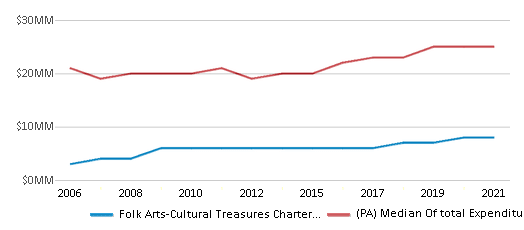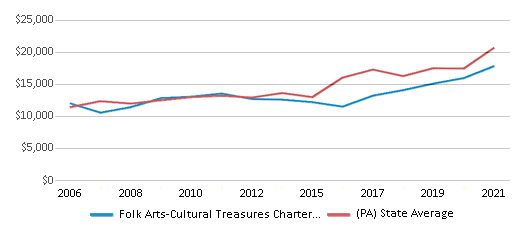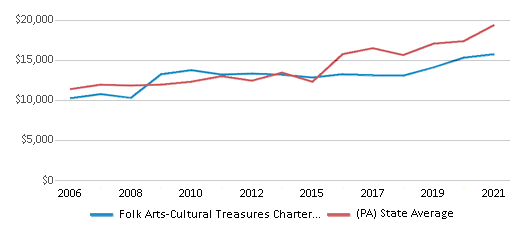Top Rankings
Folk Arts-Cultural Treasures Charter School District ranks among the top 20% of public school district in Pennsylvania for:
Category
Attribute
Overall Rank
Highest overall rank (Top 20%)
Math Proficiency
Highest math proficiency (Top 20%)
For the 2025 school year, there is 1 public school serving 494 students in Folk Arts-Cultural Treasures Charter School District. This district's average testing ranking is 9/10, which is in the top 20% of public schools in Pennsylvania.
Public School in Folk Arts-Cultural Treasures Charter School District have an average math proficiency score of 48% (versus the Pennsylvania public school average of 36%), and reading proficiency score of 65% (versus the 55% statewide average).
Minority enrollment is 90% of the student body (majority Asian), which is more than the Pennsylvania public school average of 39% (majority Hispanic and Black).
Overview
This School District
This State (PA)
# Schools
1 School
2,928 Schools
# Students
494 Students
1,668,648 Students
# Teachers
37 Teachers
124,158 Teachers
Student : Teacher Ratio
13:1
13:1
District Rank
Folk Arts-Cultural Treasures Charter School District, which is ranked within the top 20% of all 675 school districts in Pennsylvania (based off of combined math and reading proficiency testing data) for the 2021-2022 school year.
Overall District Rank
#126 out of 684 school districts
(Top 20%)
(Top 20%)

Math Test Scores (% Proficient)
48%
36%

Reading/Language Arts Test Scores (% Proficient)
65%
55%

Science Test Scores (% Proficient)
65-69%
57%

Students by Ethnicity:
Diversity Score
0.52
0.59
# American Indian Students
n/a
3,204 Students
% American Indian Students
n/a
n/a
# Asian Students
336 Students
78,034 Students
% Asian Students
68%
5%
# Hispanic Students
33 Students
249,018 Students
% Hispanic Students
7%
15%
# Black Students
37 Students
237,342 Students
% Black Students
7%
14%
# White Students
48 Students
1,011,502 Students
% White Students
10%
61%
# Hawaiian Students
n/a
1,518 Students
% Hawaiian Students
n/a
n/a
# Two or more races Students
40 Students
88,750 Students
% of Two or more races Students
8%
5%
Students by Grade:
# Students in PK Grade:
-
8,485
# Students in K Grade:
49
114,122
# Students in 1st Grade:
56
120,768
# Students in 2nd Grade:
57
126,133
# Students in 3rd Grade:
56
120,907
# Students in 4th Grade:
57
125,578
# Students in 5th Grade:
56
126,001
# Students in 6th Grade:
53
126,714
# Students in 7th Grade:
53
128,950
# Students in 8th Grade:
57
129,786
# Students in 9th Grade:
-
141,323
# Students in 10th Grade:
-
138,358
# Students in 11th Grade:
-
131,939
# Students in 12th Grade:
-
129,584
# Ungraded Students:
-
-
District Revenue and Spending
The revenue/student of $17,640 in this school district is less than the state median of $23,696. The school district revenue/student has stayed relatively flat over four school years.
The school district's spending/student of $15,599 is less than the state median of $23,119. The school district spending/student has stayed relatively flat over four school years.
Total Revenue
$9 MM
$39,541 MM

Spending
$8 MM
$38,578 MM

Revenue / Student
$17,640
$23,696

Spending / Student
$15,599
$23,119

Best Folk Arts-Cultural Treasures Charter School District Public Schools (2025)
School
(Math and Reading Proficiency)
(Math and Reading Proficiency)
Location
Grades
Students
Rank: #11.
Folk Arts-cultural Treasures Charter School
Charter School
(Math: 48% | Reading: 65%)
Rank:
Rank:
7/
Top 50%10
1023 Callowhill St
Philadelphia, PA 19123
(215) 569-2600
Philadelphia, PA 19123
(215) 569-2600
Grades: K-8
| 494 students
Frequently Asked Questions
How many schools belong to Folk Arts-Cultural Treasures Charter School District?
Folk Arts-Cultural Treasures Charter School District manages 1 public schools serving 494 students.
What is the rank of Folk Arts-Cultural Treasures Charter School District?
Folk Arts-Cultural Treasures Charter School District is ranked #129 out of 675 school districts in Pennsylvania (top 20%) based off of combined math and reading proficiency testing data for the 2021-2022 school year. This district ranks in the top 20% of Pennsylvania school districts for: Highest overall rank (Top 20%) and Highest math proficiency (Top 20%)
What is the racial composition of students in Folk Arts-Cultural Treasures Charter School District?
68% of Folk Arts-Cultural Treasures Charter School District students are Asian, 10% of students are White, 8% of students are Two or more races, 7% of students are Hispanic, and 7% of students are Black.
What is the student/teacher ratio of Folk Arts-Cultural Treasures Charter School District?
Folk Arts-Cultural Treasures Charter School District has a student/teacher ratio of 13:1, which is lower than the Pennsylvania state average of 14:1.
What is Folk Arts-Cultural Treasures Charter School District's spending/student ratio?
The school district's spending/student of $15,599 is less than the state median of $23,119. The school district spending/student has stayed relatively flat over four school years.
Recent Articles

Year-Round Or Traditional Schedule?
Which is more appropriate for your child? A year-round attendance schedule or traditional schedule? We look at the pros and cons.

Why You Should Encourage Your Child to Join a Sports Team
Participating in team sports has a great many benefits for children, there is no doubt. In this article you will learn what those benefits are.

White Students are Now the Minority in U.S. Public Schools
Increasing birth rates among immigrant families from Asia and Central and South America, combined with lower birth rates among white families, means that for the first time in history, public school students in the United States are majority-minority. This shift in demographics poses difficulties for schools as they work to accommodate children of varying language abilities and socio-economic backgrounds.





